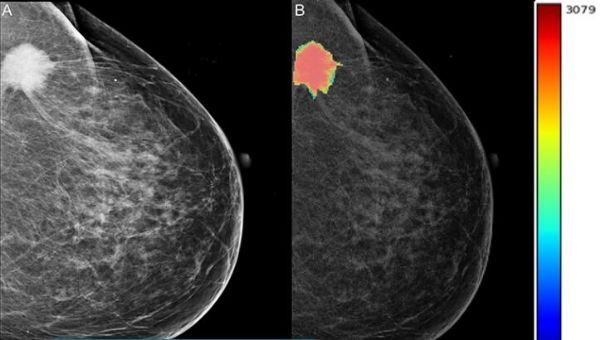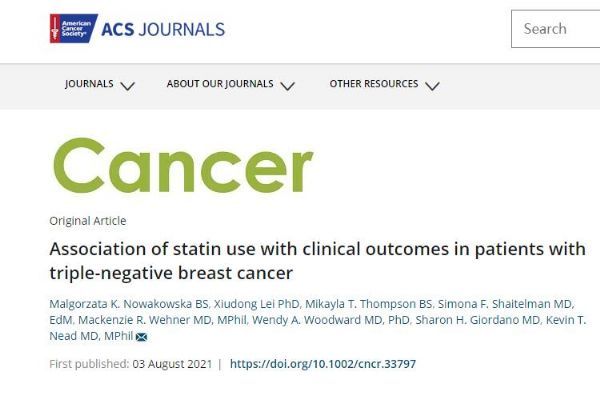Statins may significantly improve the overall survival rate of breast cancer
- Normal Liver Cells Found to Promote Cancer Metastasis to the Liver
- Nearly 80% Complete Remission: Breakthrough in ADC Anti-Tumor Treatment
- Vaccination Against Common Diseases May Prevent Dementia!
- New Alzheimer’s Disease (AD) Diagnosis and Staging Criteria
- Breakthrough in Alzheimer’s Disease: New Nasal Spray Halts Cognitive Decline by Targeting Toxic Protein
- Can the Tap Water at the Paris Olympics be Drunk Directly?
Cancer: Statins may significantly improve the overall survival rate of patients with triple-negative breast cancer
Statins may significantly improve the overall survival rate of patients with triple-negative breast cancer.
Previous studies have analyzed the correlation between statin therapy and breast cancer results, but have obtained different results;
Recently, in a research report titled “Association of statin use with clinical outcomes in patients with triple-negative breast cancer” published in the international journal Cancer, scientists from Baylor College of Medicine and other institutions found that they are named statins. There is a clear correlation between the cholesterol-lowering drugs and the survival rate of triple-negative breast cancer patients.
Because statins are low in cost, easy to obtain, and have less side effects, they may have an important impact on the treatment outcome of aggressive diseases.

picture source: Frontiers
In this study, the researcher Professor Kevin Nead and others expanded their understanding of the relationship between currently used statins and triple-negative breast cancer, and for the first time investigated the relationship between statin intake and aggressive breast cancer subtypes. ’S association.
The researchers found that after taking statins, the breast cancer-specific survival rate of patients can be increased by 58%, and the overall survival rate can be increased by 30%.
The median follow-up time for breast cancer-specific survival rate was 3.3 years, and the overall survival time was 4.4 years.
Nead said that there have been a large number of studies reporting the relationship between statins and breast cancer, but the results are not consistent; and previous studies only analyzed one disease of breast cancer, but we all know that there are many subtypes of breast cancer, so we Just want to focus on the special aggressive form of breast cancer through research, the treatment options for this kind of breast cancer are very limited.
Triple negative breast cancer is an aggressive breast cancer, which accounts for about 10%-20% of breast cancer diagnosis. Triple negative means that breast cancer does not carry estrogen or progesterone receptor or HER2 positive. It is the most common receptor for the three types of breast cancer;
This combination can lead to more aggressive breast cancer and a poor prognosis, and patients have very limited treatment options, because current therapies rarely target the receptors for triple-negative breast cancer. In this retrospective study, the researchers selected patients from SEER (Surveillance, Epidemiology, and End Results) medical insurance registry and Texas Cancer Registry medical insurance. Patients are required to have Medicare Part D prescription coverage to determine their use of statins.

Image source: https://acsjournals.onlinelibrary.wiley.com/doi/10.1002/cncr.33797
This study includes relevant data from 23,192 breast cancer patients over 66 years of age with grade I-III breast cancer. In this patient group, 2281 people will occasionally use statins, which means that they will be diagnosed after breast cancer. One-year use of statins, and accidental use of statin patients, 78.1% were white, 8.9% were black, 8.4% were Hispanic, and 4.5% were other people.
According to the analysis of breast cancer stage, the results show that accidental use of statins and the improvement of the prognosis of breast cancer patients may be the strongest in patients with early triple-negative breast cancer. When analyzing the intensity of statins, high-intensity statins Taking it has the greatest impact on the overall survival of patients with triple-negative breast cancer.
In addition, the researchers also found that the relationship between lipophilic statins (L-statins: simvastatin, atorvastatin, etc.) and the overall survival rate of patients is statistically significant.
Researcher Nead said that we all know that statins reduce the division of breast cancer cells and increase cell mortality. The results of this article show that there is a certain difference between the use of statins and the improvement of the prognosis of triple-negative breast cancer patients. Association, and now is the time to further explore this idea in prospective trials; later researchers still need to further in-depth study to explore this association, and better determine the role of statins in triple-negative breast cancer therapy Potential role.
In summary, the results of this study show that in patients with grade I, II, and III triple-negative breast cancer, statin therapy is started within 12 months after the diagnosis of breast cancer or is related to overall survival rate and breast cancer-specific survival Rate improvement is related; and statins may also have a certain effect on some breast cancer patients, of course, this needs further research to confirm later.
(source:internet, reference only)
Disclaimer of medicaltrend.org
Important Note: The information provided is for informational purposes only and should not be considered as medical advice.



